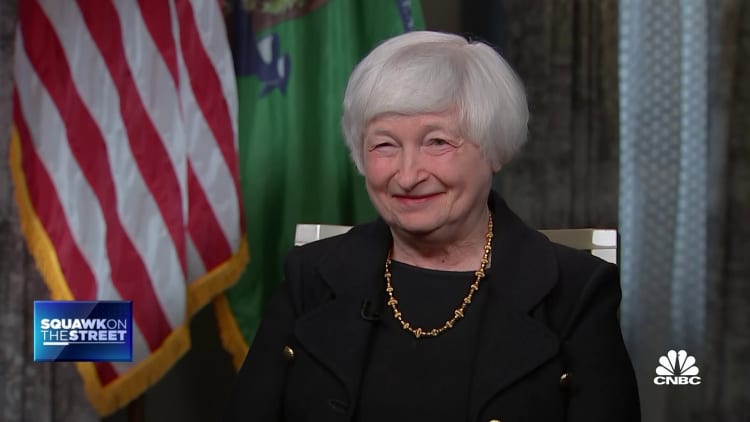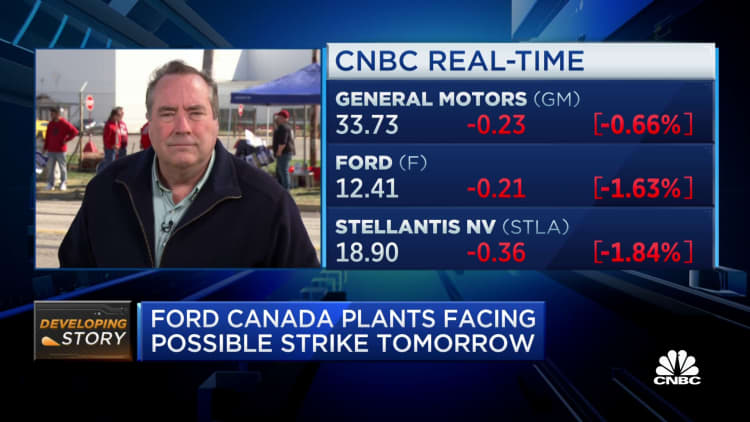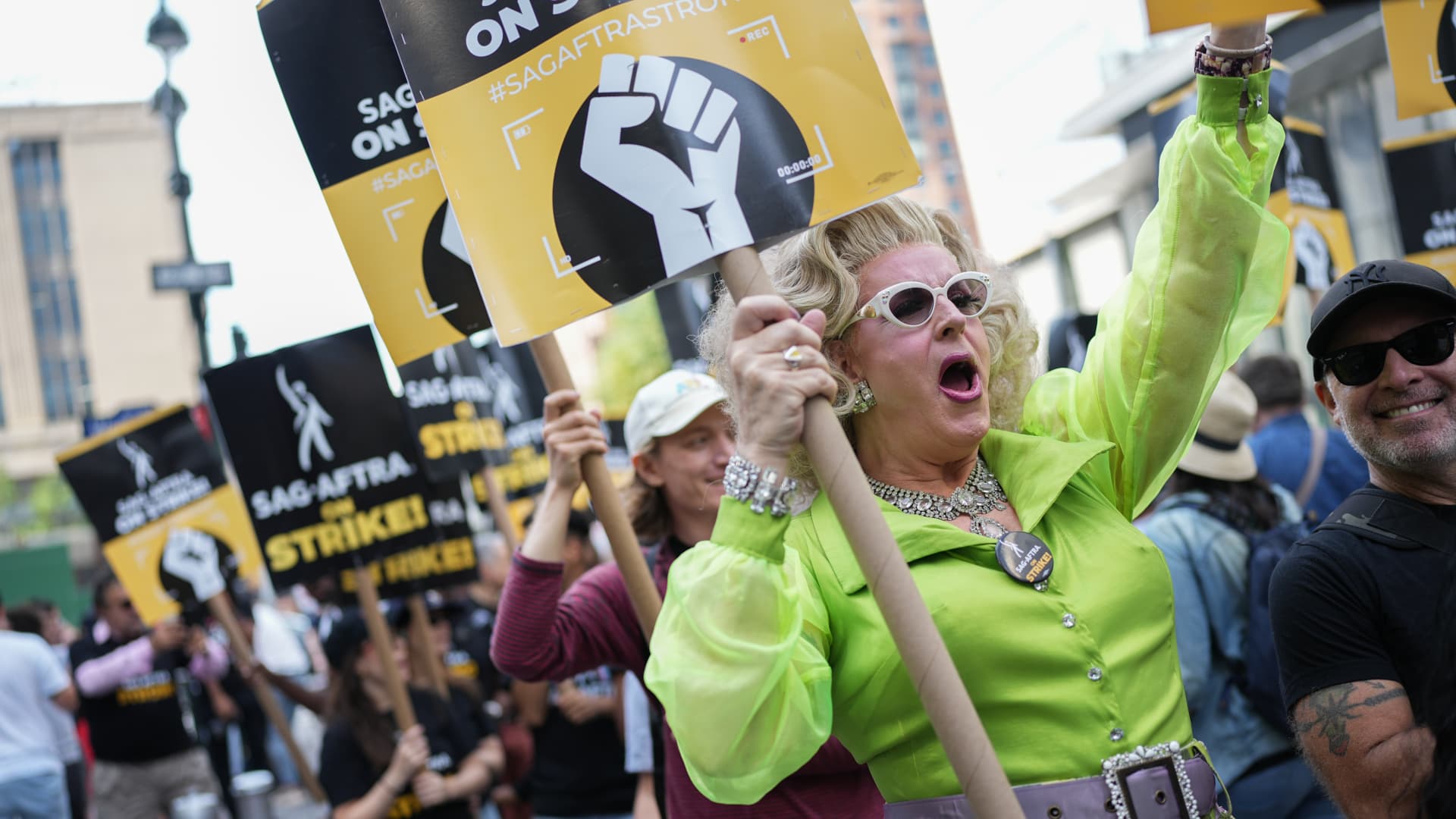
The auto workers’ strike is the latest in a series of labor-management conflicts that economists believe could have significant growth impacts if they continue. This strike by the United Auto Workers has so far affected only a small portion of the workforce and has limited implications for the broader economy.
However, it is part of a pattern of labor-management conflicts that have resulted in the most missed work hours in 23 years, according to Labor Department statistics.
“The immediate impact of the auto workers strike will be limited, but that could change if the strike is prolonged and expands,” stated Ian Shepherdson, chief economist at Pantheon Macroeconomics in a client note on Monday.
United Auto Workers (UAW) members on a picket line outside the Stellantis NV Toledo Assembly Complex in Toldeo, Ohio, on Monday, Sept. 18, 2023.
Emily Elconin | Bloomberg | Getty Images
The UAW has taken a unique approach to this strike, targeting only three factories and involving less than one-tenth of the workers at the Big Three automakers’ membership. However, if the strike escalates and includes the 146,000 union members at Ford, GM, and Stellantis, it could have greater consequences.
In such a scenario, Shepherdson estimates a potential 1.7 percentage point quarterly decline in GDP at a time when there are concerns about a possible recession. Auto production accounts for 2.9% of GDP.
A broader strike would also complicate decision-making for the Federal Reserve, which is aiming to control inflation without causing a contraction in the economy.
“The challenge for the Fed is that it would be difficult to determine in real-time how much of any economic slowdown can be attributed to the strike and how much is due to other factors, such as the impact of student loan payments restarting,” Shepherdson explained.
Labor Hours Lost
American workplaces have experienced significant labor disruptions this year. In August alone, there were 4.1 million lost labor hours, the highest for a single month since August 2000, according to the Labor Department. When combined with July, there were nearly 6.4 million lost hours from 20 work stoppages. Year-to-date, there have been 7.4 million lost hours compared to just 636 hours during the same period in 2022.
Doris Dear joins SAG-AFTRA members as they maintain picket lines in front of HBO/Amazon during the National Union Solidarity Day on August 22, 2023 in New York City.
John Nacion | Getty Images
These large numbers are the result of 20 significant work stoppages, including strikes by the Writers Guild of America, the Screen Actors Guild, state workers at the University of Michigan, and hotel employees in Los Angeles. Additionally, 60,000 healthcare workers in California, Oregon, and Washington are threatening to strike next.
After a period of relative calm, unions have become more vocal during the high-inflation era of recent years.
“If you’re a corporate CEO and you’re not anticipating labor demands, you’re disconnected from reality,” said Joseph Brusuelas, chief economist at RSM, in an interview. “After the inflation shock we’ve experienced, workers will demand higher wages since they have likely fallen behind during this period of inflation. They will also seek workplace flexibility.”
Indeed, recent data from the New York Fed reveals that workers, on average, ask for salaries close to $80,000 a year when changing jobs.
In the case of the UAW, the union has demanded a 36% raise spread over four years, similar to the pay increases received by automaker CEOs.
Inflation Impacts

Brusuelas believes that the potential 9% annual increases in the UAW’s demands are unlikely to have a significant impact on macroeconomic conditions, including inflation.
The share of the workforce represented by unions has been gradually declining and reached a record low of 10.1% in 2022, about half of what it was 40 years ago, according to the Labor Department. While 6% of private sector workers are unionized, 33% of government workers belong to unions.
“Labor disputes are expected to have a relatively small effect on the overall macroeconomy,” Brusuelas said. “Given the significant increase in inflation, this isn’t surprising or a major concern.”
The Biden administration officials also do not see any immediate economic alarms regarding the strike.
In the short term, the strike will not be reflected in the September job numbers during a period of decelerating payroll growth.
“I think it’s too early to make forecasts about what it will mean for the economy,” said Treasury Secretary Janet Yellen in an interview with CNBC’s Sara Eisen. “The duration of the strike and those affected will determine its impact. However, it’s crucial for the two sides to narrow their differences and work towards a mutually beneficial solution.”
Denial of responsibility! Vigour Times is an automatic aggregator of Global media. In each content, the hyperlink to the primary source is specified. All trademarks belong to their rightful owners, and all materials to their authors. For any complaint, please reach us at – [email protected]. We will take necessary action within 24 hours.
Denial of responsibility! Vigour Times is an automatic aggregator of Global media. In each content, the hyperlink to the primary source is specified. All trademarks belong to their rightful owners, and all materials to their authors. For any complaint, please reach us at – [email protected]. We will take necessary action within 24 hours.


